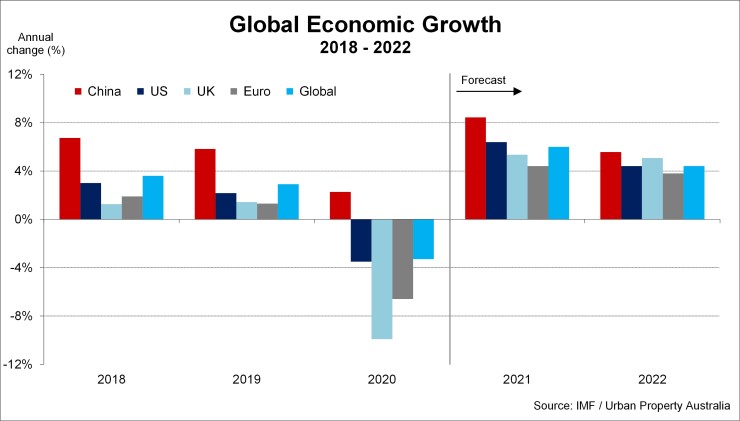Q1 2021 – Global Economic Overview
April 12th 2021 | , Urban Property Australia
Having declined by 3.3% in 2020, the global economy is projected to grow at 6.0% in 2021, with the contraction of 2020 smaller than previously projected, thanks to unprecedented policy response;
The recovery in the Australian economy is well underway with employment having recovered faster than previously forecast with 250,000 jobs added since October, which has also supported growth in household spending;
Victoria is forecast to outperform all other Australian states and territories in 2021 having experienced a strong rebound in the December 2020 quarter.
Economic Summary
Despite suffering its first economic recession in almost 30 years, Australia’s economy outperformed all the other advanced economies of the world in 2020 and has in fact recovered back to its pre-pandemic level as at April 2021. If not for the extraordinary policy support of governments and central banks globally, the overall impact of the coronavirus recession would have been three times larger with the global economy forecast to now expand by 6.0% in 2021.

One year into the COVID-19 pandemic, the accumulating human toll continues to raise concerns, even as growing vaccine coverage lifts sentiment. High uncertainty surrounds the global economic outlook, primarily related to the path of the pandemic. The contraction of activity in 2020 was unprecedented in its speed and synchronized nature. If not for extraordinary policy support, the economic consensus suggest that the contraction could have been three times as large.
After a contraction of 3.3% in 2020, the global economy is projected to grow at 6.0% in 2021, moderating to 4.4% in 2022. The contraction for 2020 was smaller than projected, reflecting the higher-than-expected growth for most regions after lock- downs were eased and as economies adapted to new ways of working.
Thanks to unprecedented policy response, the COVID-19 recession is likely to leave smaller scars than the 2008 global financial crisis. However, emerging market economies and low-income developing countries have been hit harder and are expected to suffer more significant medium-term losses.
Overall, global economic activity is expected to recover faster than in a typical recession because much of the weakness has been the result of mandated constraints rather than weak demand.
United States
The U.S. economy is recovering following the sharp fall in GDP and the dramatic rise in the unemployment rate in the first half of 2020. The IMF raised its U.S. outlook sharply in 2021 to 6.4% this year from 5.1%. The U.S. should see solid 4.4% growth in 2022. The extent of fiscal support in the United States this year is set to be considerably larger than in most other economies. This strong fiscal support should strengthen demand substantially and enable a stronger recovery from the pandemic, with beneficial spillovers for other economies, particularly Canada and Mexico.
China
After contracting sharply in early 2020, the Chinese economy has largely recovered and is forecast to expand by 8.4% in 2021. Activity is now well above pre-pandemic levels in most parts of the economy. This economic resilience has stemmed from China’s ability to avoid large-scale outbreaks of the virus since early 2020 and to effectively target economic policy support measures. The early stages of the recovery were driven by construction-related investment and production, partly because fiscal spending was largely directed towards infrastructure projects.
Europe
In the major European advanced economies, the pace of the recovery has been more modest than other global regions, reflecting extended disruptions from renewed virus outbreaks and associated reductions in working hours in many service sectors. The different sector specialisation of economies is also affecting growth, with the economies most dependent on international travel and tourism generally experiencing a larger GDP decline in 2020. The European Union and the United Kingdom reached a trade agreement in late December, which should limit large-scale disruptions to a key trading relationship following Brexit.
United Kingdom
The UK economy declined by 11.2% in 2020, with growth of 4.2% in 2021 and 4.1% in 2022 projected, driven by a rebound of consumption, while business investment will remain weak due to spare capacity and continued uncertainty. Increased border costs will weigh on imports and exports from 2021 as the United Kingdom leaves the EU Single Market. Labour market withdrawals and unemployment will increase even though the Coronavirus Job Retention Scheme continues to support employment with the unemployment rate projected to average at 7.4% in 2021.
India
In India, the pace of economic recovery has strengthened alongside a decline in COVID-19 cases and a further relaxation of restrictions. Following severe disruptions during India’s initial lockdown, industrial production has continued to recover and steel production is now around pre-pandemic levels. Steel demand is supporting an increase in demand for Australian coking coal exports to India. Nonetheless, overall economic activity is still below pre-pandemic levels, particularly in parts of the services sector. With India’s economy having contracted by 8.0% in 2020, the economy is projected to increase by 12.5% in 2021 and 6.9% in 2022.
Copyright © 2021 by Urban Property Australia All rights reserved. No part of this publication may be reproduced in any form, by microfilm, xerography, electronically or otherwise, or incorporated into any information retrieval system, without the written permission of the copyright owner.



